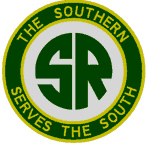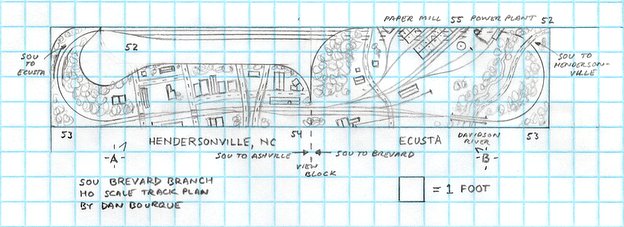- Size: 6′ x 22′
- Scale: HO
- Minimum Radius: 22″
- Minimum Aisle Width: N/A″
- Designed by Dan Bourque
 The Southern’s Brevard Branch stretched from Hendersonville, NC to Lake Toxaway, NC in the foothills of the Appalachians. The largest customer on the line was the paper mill in Ecusta, and in the 1980s the line was cut back to Ecusta, just short of the line’s namesake, Brevard. This branch was far from the coal fields, but a power plant at the mill received coal, so hoppers were a common sight along with tank cars and boxcars. The mill at Ecusta made fine paper for Bibles and cigarettes from flax and pulp which arrived in boxcars. Other customers included fuel dealers, a concrete plant, a lumberyard and pulpwood loading.
The Southern’s Brevard Branch stretched from Hendersonville, NC to Lake Toxaway, NC in the foothills of the Appalachians. The largest customer on the line was the paper mill in Ecusta, and in the 1980s the line was cut back to Ecusta, just short of the line’s namesake, Brevard. This branch was far from the coal fields, but a power plant at the mill received coal, so hoppers were a common sight along with tank cars and boxcars. The mill at Ecusta made fine paper for Bibles and cigarettes from flax and pulp which arrived in boxcars. Other customers included fuel dealers, a concrete plant, a lumberyard and pulpwood loading.
The Layout
This layout was designed for a friend who has an unusual space for a layout, an elevated 4′ x 20′ platform in the corner of a room. The room could be used for aisle space, but the layout had to be contained within the 4′ x 20′ area, and it needed to be HO scale and single-deck with a desire for realistic switching operations and the ability for continuous running. To model the operations of the Brevard Branch effectively, there were two key scenes. The first was Hendersonville where the branch left the Southern’s Asheville, NC to Spartanburg, SC mainline. The second was the paper mill at Ecusta. These scenes were several miles apart on the prototype, so it became apparent that the two scenes would split the layout and be joined by a loop around the back of the layout to simulate distance. Unfortunately, the scenes at Hendersonville and Ecusta required a lot more than 10 feet of linear space. I couldn’t help but notice that both Hendersonville and Ecusta were comprised of three tracks, a main and two side tracks, so rather than stack the two scenes on top of one another, I used a set of “common tracks” to represent the main and side tracks for both towns with a scenic divider down the middle to separate the two scenes. It takes some imagination, but it actually lends itself to prototypical switching and operation while allowing for continuous running (which I’ll cover more in the “Operations” section).
The layout is significantly compressed but includes key features from each scene. In Hendersonville, the key feature is the classic Southern station along the main and the double bridges crossing the railroad. In Ecusta, the key feature is the paper mill. Only a small portion of the large mill is modeled against the backdrop, but pictures or flats could be used to make the scene look larger. There was a small yard between the main and the mill tracks on the prototype, but this was a casualty of the compressed design. Also included is the bridge crossing the Davidson River on the east side of the scene. I added a highway overpass to hide where the track enters the three-track staging yard. This yard isn’t really required for operations, but it allows multiple trains to be stored on the layout which makes continuous running more interesting when you just want to watch trains.
Construction would be simple and straightforward. I envision open grid construction and cookie-cutter subroadbed to give elevation to the scenes. It’s small enough to be powered by an entry-level DCC system like an MRC Prodigy or NCE Power Cab, and walk-around throttles would be needed to perform all the switching.
Operations
Operations would accommodate 1-2 operators and take an hour or so to complete all the switching. The only train needed would be a Brevard Branch Local which would start in staging facing to the right (toward Ecusta). Motive power would vary based on era, but figure a pair of older, lighter Southern units like F-units, GP7s or even an SD9 in the ’60s and early ’70s and perhaps some GP38s in the late ’70s and ’80s. The layout would accomodate 15-20 car trains which will make for plenty of switching. The main duty is switching the paper mill, but a handful of shorter sidings for smaller industries (some of which are facing point moves) would add to the complexity of switching and variety of cars.
Making the operations prototypical with a loop takes a little imagination, but here’s how it would work. The “common tracks” would first be used to represent Hendersonville, so the operator stands in the aisle near spot A. The train transits through Ecusta on its way from staging, but for the operator, those tracks just represent the tracks from Asheville. The operator works Hendersonville, using the run around to do a set out or two and to grab cars that may have been left on the siding earlier by a northbound train (staged on the layout before the session). The operator would then take the switch to the Brevard Branch, and the train would exit stage left. While the train is transiting its 16 miles to Ecusta behind the layout, the operator would reposition near spot B, and the “common tracks” become Ecusta. The train enters from behind the layout stage right, crosses the Davidson River, and enters Ecusta. Once in Ecusta, the operator would work the mill, power plant and small sidings swapping cars in and out which should take a good while, and almost everything can be done without the operator having to leave the Ecusta side of the divider. Once everything’s in the right spot, the operator makes a final run around to get the locos on the right side of the train and exits stage right to go back to Hendersonville. As the train is behind the layout, the operator once again moves to spot A, and the common tracks become Hendersonville again. Train enters stage left, and after setting out any southbounds, the operator proceeds up the main toward Asheville and exits stage right to staging.
Things I Like About this Plan:
- Continuous running
- Captures key elements of two major scenes
- Prototypical switching operations despite design compromises
Things I Don’t Like About this Plan:
- Tracks used for more than one scene
- Non-optimal layout divider in middle of layout
- Staging difficult to access
- Very compressed
Related Products:





